Race introduction: Pornichet Select 6.50
The first race for me this season will be the Pornichet Select 6.50 which is organized by CNBPP in Pornichet La Baule.
With roughly three weeks until the start on April 12th at 1pm here’s a quick intro to the race to warm you up.
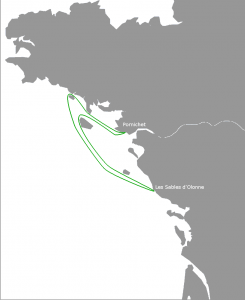
After the start in the bay of Pornichet we turn right and face northwest. No time to relay though, the first decision has to be made: do we stay in the “channel” between Belle Île and Quiberon/Hoedic/Houat or do we stay between Quiberon/Hoedic/Houat to avoid possible oncoming current and choppy waves.
We then make our way towards Birvideaux lighthouse which stands alone on a shallow north of Belle-Île and round it in the first night to start our way south.
Time for our next decision: Belle-Île is known for creating zones of light winds both on windward and leeward of the island, especially in the morning hours. So do we stick with the pack and take the direct route or do we go offshore and try to avoid the possible calm?
In any case, seeing Belle-Île at night with the lights of our 60-ish competitors will be a spectacular sigh.
The morning of the second day it’s time to focus a bit because the shipping lanes towards Nantes pass between Belle-Île and Île d’Yeu so we better keep our eyes open and the AIS on. Ideally around lunchtime the second day we will leave Île d’Yeu to our left and head to Les Sables d’Olonne. In 2013 this was a drag race dead downwind.
In front of Les Sables d’Olonne we now round the cardinal buoy “Nouche Sud”, then turn our back on Les Sables make our way back towards Île d’Yeu which we will leave to our right during the second night.
During dusk or the morning hours we are facing Belle Île again (remember the calms?) but this time we have the choice whether we want to pass to the east or the west of it so we should consider the currents which way to go.
While Belle-Île disappears behind us we make our way north towards Île de Groix which is located outside of Lorient so an area that most mini-ists know fairly well. We probably arrive during the third night and make our way up the westerly coast which is not very populated so the high cliffs remain dark and only the lighthouse Pen Men looms above the northern tip of the island.
We round the northern tip and now make our way back south, the island on our right.
We now have to juggle three things:
– the island is fairly high hence creates calm in its lee so it can make sense to head towards land for better wind
– the currents are fairly strong so if there’s wind at the island it may make sense to do bayhopping and stay close to the island to avoid current
– close to the island there are a lot of fishtraps, nets and submerged rocks
So we better make sure we are fresh and focused for this part of the race.
We leave Île de Groix behind us and proceed south towards Île de Quiberon and Belle Île, probably during the night. Depending on the tides we now have to decide again: stay in the channel or seek cover in between Quiberon/Houat/Hoedic and the land.
Now there’s only one shallow to round before we make our back into the bay of Pornichet to finish.
Well done, we just finished our 300nm solo race!
The main challenges of this race for me are the length (too long to stay awake, too short to allow yourself to sleep and be able to catch up), the temperatures (especially at night it’s still very cold) and the many tactical decisions on currents and winds around the many islands.
Did you know? #7: Boat numbers
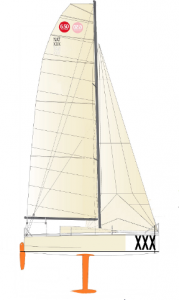 Once built, each mini 6.50 gets assigned a unique boat number by Classe Mini which will stay with the boat for its whole “boat life”.
Once built, each mini 6.50 gets assigned a unique boat number by Classe Mini which will stay with the boat for its whole “boat life”.
This has not always been the case. Up until about 1995 the boat numbers were reassigned on every Mini Transat.
Currently the latest boat number for a newly built boat is the 864 for a RG6.50 series boat. You can look those up for all registered boats here.
The boat number has to be carried on the hull (the bow), the mainsail and the solent (all the places marked with XXX on the image).
Having boat numbers on the hull is common in offshore classes (like the minis, class 40, open 60, mod 70, etc.) so that the boats can be easily identified by planes or helicopters. That’s why the boat number also has to be painted on the deck.
My boat number is the 732, in a fresh design for 2014:
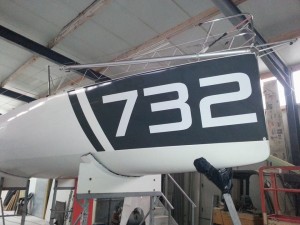
Navigation prep brouhaha
Since the last two weeks were swamped with work (read day job work) there was hardly any time left to prepare things for the boat in the evenings.
So I decided it’s time for my first brouhaha with the topic “navigation prep”.
The goal for the end of the week is:
1) to have all important landmarks, buoys, etc. marked as waypoints in Adrena
2) creating draft routes for the races to come
3) creating routes for narrows (e.g. between Hoedic/Houat/Ile de Quiberon) and to write down the maximum allowed cross track error (so that I can tack through those narrows)
4) exporting all waypoints so that I can print them lateron to have as a backup on board
5) putting all important waypoints into the paper charts with their 6-letter code (my Furuno GPS only allows waypoint names of maximum 6 characters)
6) preparing a rough roadbook for each race so it’s less work the last days before each race.
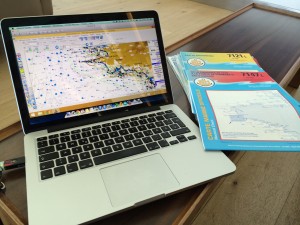 Now I had to leave for a one week business trip to the US on a bit of a short notice but I decided that that won’t stop me. I tool all (!) my paper charts with me and will do the navigation prep for the races on the atlantic coast and the qualifier while on the road. Every minute counts will be my motto for the weeks to come.
Now I had to leave for a one week business trip to the US on a bit of a short notice but I decided that that won’t stop me. I tool all (!) my paper charts with me and will do the navigation prep for the races on the atlantic coast and the qualifier while on the road. Every minute counts will be my motto for the weeks to come.
By the way, all the waypoints will be uploaded from the laptop to the gps later when I’m back on board.
The photo shows how I repurposed parts of the BA Lounge in Heathrow to my personal navigation prep room.
Did you know? #6: How to avoid your Code0 from unfurling
Nowadays all Minis have the more or less the same sail wardrobe which contains one Code Zero (historically called Gennaker “Genak” by the french) which is used for going upwind in light winds and for reaching.
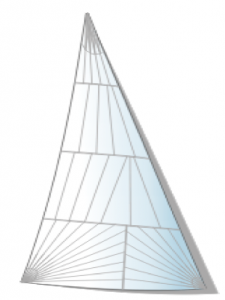 The rule of thumb for the Code 0 (a FR0 if for the experts) is that it should have roughly the same size as the main sail, so about 30sqm and it is being used on a furler.
The rule of thumb for the Code 0 (a FR0 if for the experts) is that it should have roughly the same size as the main sail, so about 30sqm and it is being used on a furler.
One problem of furling sails though is that they tend to unfurl themselves when being set because there are no sheets wrapped around it.
The mini sailors have a simple trick for that: Velcro tape
The sailmaker sews 2-3 stripes around the clew: one side vertically, horizontally on the other.
Now when the sail is being furled it is sticks to itself which is holds up surprisingly well: even in choppy conditions going upwind the sail does not unfurl itself.
To unfurl it you simply pull the sheet and the velcro will give way.